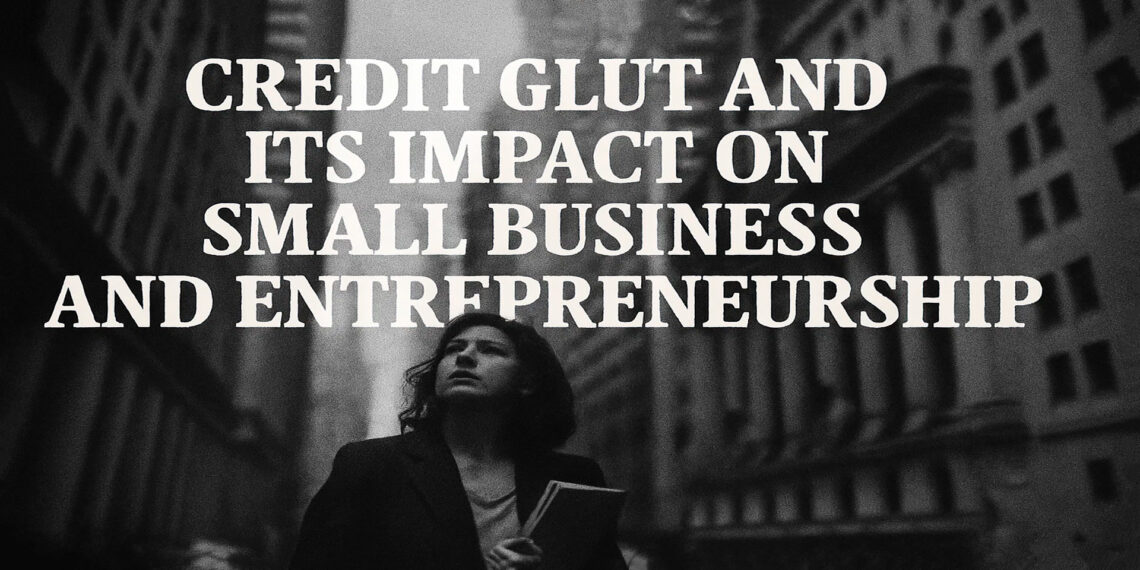
Credit Glut and Its Impact on Small Business and Entrepreneurship
On the surface, it looks like a golden era for small businesses. Loans are easy to get, interest rates are historically low (or at least were for a long time), and lenders seem to be everywhere — from big banks and fintech startups to peer-to-peer platforms offering money in minutes. It should be the perfect environment to launch a business. But there’s a hidden problem: too much credit can do more harm than good. When money is cheap and plentiful, it changes how people build businesses — and not always for the better.
When Easy Credit Fuels Fragile Businesses
In a healthy lending environment, entrepreneurs borrow cautiously. They run the numbers, test the market, and only take on debt when it supports a clear, sustainable plan. But in a credit glut — when money floods the system — that caution fades. Loans become a shortcut to launching quickly, often before a business is ready. And when money is too easy to access, the bar for entering the market drops. That doesn’t just invite innovation. It also opens the door to underdeveloped ideas, overoptimistic founders, and poorly planned growth.
Access to capital should support smart risk. But what we’re seeing instead is the rise of businesses built on borrowed money rather than real demand. Many startups don’t have solid revenue, a loyal customer base, or even a clear path to profitability — but they do have funding. They launch because they can, not because the market needs them. That kind of foundation is shaky. And when the economy tightens or interest rates climb, these businesses often struggle to survive.
The Illusion of Momentum
It’s easy to confuse borrowed money with progress. With enough capital, you can hire a team, rent office space, build a product, and run ads — fast. From the outside, it looks like momentum. But inside, it’s often hollow. A business built entirely on debt, without revenue to support it, is racing against time. Every month adds pressure to repay, generate cash flow, or raise more funds. Many founders assume that growth will arrive before the money runs out. But if it doesn’t, they’re left with debt and no fallback.
This issue becomes more dangerous when borrowing continues as a solution to early challenges. Struggling to acquire customers? Take out a marketing loan. Behind on payments? Refinance the first loan with a second. Instead of slowing down and reassessing, founders are encouraged to keep going — because the credit is still available. This debt-stacking creates a fragile ecosystem where a single misstep — a bad quarter, a delayed invoice, or rising interest — can trigger a collapse.

How Easy Credit Distorts Business Behavior
When money is cheap and flowing, it changes how people think. Instead of building businesses that grow gradually, based on real demand, founders are pushed to scale quickly. They hire early, spend big on branding, invest in high-cost marketing, and expand into new markets before their core offering is stable. This rapid growth isn’t always backed by real results — it’s backed by credit. And when the financial cushion comes from a lender rather than the business itself, the risks multiply.
In this environment, patience becomes rare. Founders feel pressure to look successful, not just be successful. Offices, websites, press releases — they’re all designed to attract investors, customers, or partners. But the foundation may still be untested. What looks like traction is often just spending. Credit turns optics into a strategy. And when competition heats up, everyone feels the need to borrow just to keep up.
Credit Crowds the Market — Then Thins It Out
Easy credit doesn’t just affect individual businesses — it reshapes entire industries. When borrowing is simple and funding is everywhere, more people start companies. That can lead to positive disruption — but also to saturation. Markets become crowded with similar offerings, from food delivery to fashion startups to personal finance apps. Everyone is competing for the same customers, with the same borrowed money.
This overpopulation creates a race to the bottom. Companies slash prices, offer unsustainable perks, or overspend on advertising just to gain attention. The battle isn’t about building a better product — it’s about who can outlast the others financially. And when the credit dries up, or interest rates rise, many of these businesses fold. What looked like a booming sector suddenly shrinks. The businesses left standing aren’t always the most innovative — just the ones that borrowed less and managed better.
“Supportive” Lenders May Not Be So Supportive
Many lenders claim to support entrepreneurship. And to be fair, some genuinely do — offering coaching, flexibility, or fair terms. But in a saturated market, lending also becomes competitive. Financial institutions push their products harder. Some prioritize volume over quality. They know many startups will fail, but the math still works out if enough pay back on time. That puts entrepreneurs in a risky position. They’re told that taking a loan is part of the journey, that borrowing is how business works now.
But real support doesn’t mean encouraging someone to take on debt they may not be able to manage. It means helping them understand what they’re signing up for. What’s the repayment schedule? What happens if revenue doesn’t materialize? Is this loan building capacity — or just extending risk? These are the questions many founders don’t ask until it’s too late. Because the offer looked friendly. And because the cash came fast.

The Emotional Cost of Credit Dependency
Borrowing is financial — but it’s also emotional. Founders often tie their self-worth to their company’s success. When the business runs on loans, every missed sale or shortfall adds stress. Repayments loom. Bills pile up. The pressure grows. Some business owners keep borrowing, trying to stay afloat. Others freeze. They lose confidence. The fear of failure becomes overwhelming. And often, they’re doing this alone.
In some cases, founders take personal guarantees on loans. That means if the business fails, the debt follows them. Their savings, their home, their credit — all at risk. What started as a dream of independence becomes a burden. It’s a story that plays out quietly, in cafes and coworking spaces, far from the headlines about funding rounds and startup launches.
What Responsible Borrowing Looks Like
Credit, used right, can be a powerful tool. The key is timing, intention, and discipline. Borrowing should be based on evidence — sales, contracts, demand — not on hope. It should come with a plan for repayment, not a wish that the business will catch up later. Smart borrowing helps a business grow faster. Reckless borrowing speeds up failure.
Before taking a loan, founders should ask:
- Is this debt necessary, or just convenient?
- Will it directly lead to growth or stability?
- What happens if the growth takes twice as long?
- Can I repay this without additional loans?
If the answers aren’t clear, it may be better to wait — or grow more slowly.
The Conclusion
Credit should support entrepreneurship, not distort it. But when money floods the market, it creates a false sense of readiness and a race to borrow first, plan later. That weakens businesses, inflates competition, and puts real pressure on founders. The path to sustainable growth doesn’t start with loans — it starts with clarity. Clear demand. Clear plans. Clear limits. Without those, cheap credit becomes an expensive mistake.
